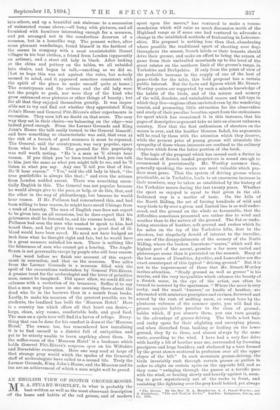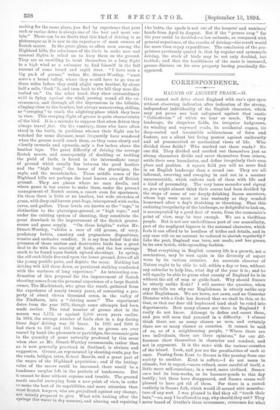AN ENGLISH VIEW OF SCOTCH GROUSE-MOORS.
MR. A. STUART-WORTLEY, in what is probably the best-written as well as the most observant description of the home and habits of the red grouse, and of modern sport upon the moors,5 has ventured to make a recome mendation which will raise as much discussion north of the Highland range as if some one had ventured to advocate a change in the established methods of foxhunting in Leicester- shire. His proposal is nothing less than that, abandoning where possible the traditional sport of shooting over dogs throughout the season, Scotch lairds or their tenants should drive their grouse, and make an effort to bring the return of game from their unrivalled moorlands up to the level of the great estates on the southern limit of the grouse's range, in Yorkshire and Derbyshire. If only from the point of view of the probable increase in the supply of one of the best of game-birds for the table, this bold proposal has a certain public interest. But the facts and figures which Mr. Stuart- Wortley quotes are supported by such a minute knowledge of the habits of the birds, and of the nature and scenery of the wild, desolate, and uninhabited moors and hill-tops in which they live—regions often unvisited even by the wandering tourist, and presenting little attraction for the observation and study of their peculiar beauties, apart from the enthusiasm for sport which has occasioned it in this instance, that his pages of descriptive argument take us into an almost unknown country. Now that the first enthusiasm of shooters on the moors is over, and the heather blossom faded, his arguments will be read by them with the attention which they deserve, while the present price of young grouse will stimulate the sympathy of those whose interests are confined to the culinary chapters which form the latter portion of the book.
The logic of the proposal which has caused such a flutter in the breasts of Scotch landed proprietors is sound enough to recommend it provisionally, Mr. Wortley assumes that, generally speaking, the moors are most valuable which pro- duce most game. That the system of driving grouse where practicable, as in Yorkshire, leads to an enormous increase in their numbers, may be taken as established by the history of the Yorkshire moors during the last twenty years. Whether the sport so enjoyed is equal to that given in the old. fashioned way is a matter of taste. On the hills of the North Riding, the art of forcing hundreds of wild and wary birds to fly over a given and limited line is so well under- stood, and the ground on the whole so favourable, that the difficulties sometimes presented are rather due to wind and weather than to the nature of the ground. The fiat or undu- lating stretches of heather, soft ground and rashes which lie for miles on the top of the Yorkshire hills, dear to the shooters, but singularly devoid of interest to the traveller, are one of the disappointments of the scenery of the North Riding, where the broken limestone-" seam," which wall the highest part of the ascent, promise a far more varied and picturesque scene than is presented on the summit. Many of the low moors of Dumfries, Ayrshire, and Lancashire are the exact counterpart of this typical " driving-ground." Bat it is not to the improvement of these that Mr. Stuart-Wortley invites attention. "Study ground as well as grouse" is his maxim, and the very inequalities which enhance the beauty of a Scotch moor, in the eye of the artist, can of ten be turned to account by the sportsman. '• Where the moor is very rocky, and the small knowes,' or knolls of heather, are alternated with miniature precipices and ravines, furrowed and scored by the rush of melting snow, or swept bare by the plenteous volumes of the summer spate, you will find the grouse acquire habits peculiar to the class of ground ; habits which, if you observe them, you can turn greatly to the advantage of grouse-driving. The birds select bare and rocky spots for their alighting and surveying places. and when disturbed from basking or feeding on the lower ground, they fly to these, and almost always by the same route, according to the wind. I have had a very fine drive with hardly a bit of heather near me, surrounded by frowning precipices and huge boulders, and sheltered by a butt formed by the great stones scattered in profusion over all the upper slopes of the hill." In such mountain grouse-driving, the birds invariably rush through certain passes or gullies in order to alight on certain spots on the opposite hill, and as they come " swinging through the passes at a terrific pace with the wind, or beating slowly and heavily against it, seem- ing to grow mysteriously out of the rocks in front, and vanishing like lightning over the grey knoll behind, yet always • The Grouse. By the Rev. H. A. Maophorf.on. A. J. Stuart-Worilov, end G. Faintsbury. "Fur and Foattler ecrion." London Longman, Green, and Co. 1894. making for the same place, you find by experience that your rock or ravine drive is always one of the best and most cer- tain." There can be no doubt that this kind of driving is as picturesque as it is new to the experience of most owners of Scotch moors. In the great glens, so often seen among the Highland hills, the reluctance of the birds to make new and unusual flights is relied on to keep them on the ground. They are as unwilling to trust themselves to a long flight in a high wind as a swimmer to find himself in the full current of some broad and rapid river. "I have seen a big pack of grouse," writes Mr. Stuart-Wortley, "start across a broad valley, where they would have to go two or three miles before they could alight upon heather, fly about half a mile, funk' it, and turn back to the hill they were dis- turbed on." On the other hand, they show extraordinary skill in flying against the wind, passing round all the ex- crescences, and through all the depressions in the hillside, clinging close to the heather, but always manoeuvring, sidling, or " creeping " to reach the alighting-place which they have in view. This creeping flight of grouse is quite characteristic of the bird. It is a mistake to suppose that when driven they always travel fast. On the contrary, those who have often stood in the butts, in positions whence their flight can be watched for some distance, must frequently have wondered when the grouse would reach them, as they come slowly and silently onwards and upwards, only a few inches above the heather tops. The great difficulty of driving the average Scotch moors, and consequently of doubling or trebling the yield of birds, is found in the intermediate range of ground which usually lies between the good heather and the "high tops," the home of the ptarmigan, the eagle, and the mountain-fox. These middle zones of the Highland hills are perhaps the least known area of British ground. They are places where no man dwells, and where game is too scarce to make them, under the present management of Scotch moors, a resort even for sportsmen. On them there is little or no heather, but wide stretches of grass, with deep and barren peat-bogs, interspersed with rocks, caves, and gullies. These levels are known as the " tops," in distinction to the ptarmigan-ground, or "high tops ; " and under the existing system of shooting, they constitute the great drawback to the improvement of the Scotch grouse- moors and game supply. " On these heights," writes Mr. Stuart-Wortley, "abides a race of old grouse, of wary, predatory habits, amatory and pugnacious dispositions, evasive and exclusive conduct. It is my firm belief that the presence of these useless and destructive birds has a great deal to do with the scarcity of birds, and the low average stock to be found upon Scotch upland shootings. In spring, the old cock-birds descend upon the lower ground, drive off all the young prolific pairs, and deplete the moor. Nothing but driving will kill them down, or persistent stalking conducted with the wariness of long experience." An interesting con- firmation of this proposal for the improvement of Scotch shooting comes from the personal experience of a large Scotch owner, The Mackintosh, who gives the result, gathered from the experience of nearly twenty years, of converting a pro- perty of about eleven thousand acres, in the valley of the Findborn, into a " driving moor." The experiment dates from the year 1879, though some attempts had been made earlier. The total number of grouse shot in the season was 5,172, as against 3,000 seven years earlier. In 1884, the average number of birds shot in a day during three days' driving was 94 brace. In 1885 and 1886 it had risen to 130 and 165 brace. As no grouse are ever reared by hand like pheasants or partridges, the economic gain in the quantity of game naturally produced by this moor when shot as Mr. Stuart-Wortley recommends, rather than as is now generally practised in Scotland, is obvious and suggestive. Grouse, as represented by shooting-rents, pay for the roads, bridges, rates, School Boards, and a great part of the wages of the Highland population ; and if the letting- value of the moors could be increased, there would be a handsome surplus left in the pockets of landowners. But it cannot be done without expense and trouble. The ground needs careful surveying from a new point of view, in order to make the best of its capabilities, and more attention than most Scotch keepers, who are prejudiced against any change, are usually prepared to give. What with looking after the springs (for water in dry seasons), and altering and repairing the butts, the spade is not out of the keepers' and watchers' bands from April to August. But if the "grouse crop" for the year could be doubled—a low estimate, as compared with general experience, of the results of driving—the result would. far more than repay expenditure. The conclusion of the pro- prietors previously quoted is, that by regular and systematic driving, the stock of birds may be not only doubled, but trebled ; and that the healthiness of the moor is increased,. grouse diseases on his own property having practically die- appeared.



































 Previous page
Previous page